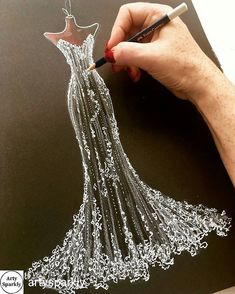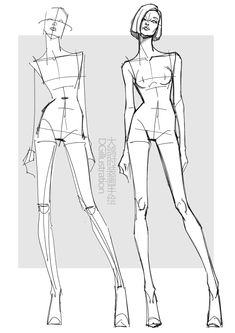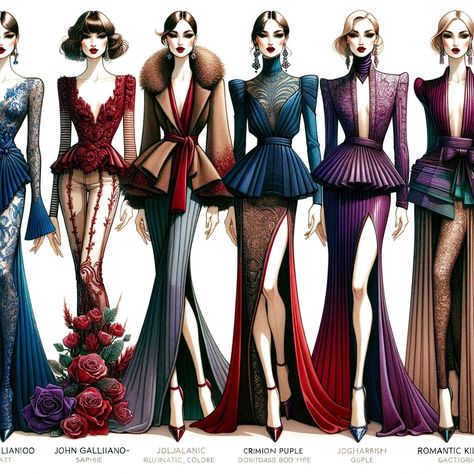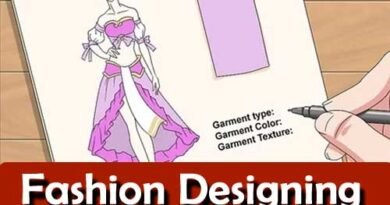Importance of Fashion Ilustration in Fashion Design
Fashion illustration serves as a cornerstone in the world of fashion design, playing a vital role in conceptualization, communication, and expression within the industry. This class note explores the multifaceted importance of fashion illustration, delving into its historical significance, practical applications, educational value, and contemporary relevance.
Historical Significance

Fashion illustration has a rich history intertwined with the evolution of fashion itself. Before the advent of photography, illustrations were the primary means of depicting clothing designs, conveying trends, and capturing the essence of style. Artists throughout history have contributed to the development of fashion illustration as an art form, from the detailed sketches of Renaissance masters to the stylized depictions in 20th-century fashion magazines.
During the 19th and early 20th centuries, fashion illustration reached its zenith as magazines like Vogue and Harper’s Bazaar showcased the work of illustrators like Rene Gruau, Antonio Lopez, and Erte. These illustrations not only depicted clothing but also encapsulated the mood, glamour, and allure of the fashion world, influencing public perception and shaping trends.
Practical Applications in Fashion Design
Fashion illustration serves several practical purposes in the design process:
- Visualization of Ideas: Fashion designers use illustrations to visualize their concepts and translate abstract ideas into tangible designs. Illustrations allow designers to explore different silhouettes, details, and color combinations before committing to a final prototype.
- Communication Tool: Illustrations bridge the gap between designers, clients, and manufacturers by effectively communicating design concepts. They convey the intended look and feel of a garment, ensuring that everyone involved in the production process shares a common vision.
- Pattern Making and Garment Construction: Fashion illustrations provide essential guidelines for pattern makers and garment constructors. Detailed illustrations with accurate proportions, seam placements, and fabric textures help ensure that the final garment matches the designer’s original vision.
- Portfolio Development: For aspiring fashion designers, a strong portfolio showcasing proficient fashion illustration skills is crucial for gaining entry into design schools and securing internships or employment opportunities within the industry.
Educational Value

Fashion illustration plays a pivotal role in the education and development of future fashion designers:
- Skill Development: Learning to sketch fashion figures, drape fabrics, and render textures improves an aspiring designer’s technical proficiency and artistic ability. These skills are fundamental to effectively communicating design ideas and creating visually compelling presentations.
- Understanding Design Principles: Through illustration, students learn about proportions, anatomy, garment construction, and the principles of design such as balance, proportion, and rhythm. These principles inform every aspect of fashion design, from sketching initial ideas to executing final collections.
- Creative Expression: Fashion illustration encourages creative exploration and experimentation with different styles, techniques, and media. It provides a platform for students to develop their unique artistic voice and explore diverse themes and inspirations.
- Historical Context: Studying fashion illustration offers insights into the historical evolution of fashion trends, styles, and cultural influences. By examining illustrations from different eras, students gain a deeper understanding of how fashion has evolved over time and its impact on society.
Enhancing Design Communication
Effective communication is essential in fashion design, and fashion illustration serves as a powerful tool for conveying ideas and intentions:
- Visual Clarity: Illustrations provide a clear visual representation of design details, proportions, and styling choices that may be challenging to convey through verbal descriptions alone.
- Client Presentations: Designers use illustrations to present their collections to clients, showcasing key pieces, color palettes, and styling options. Well-executed illustrations help clients visualize how garments will look and fit, facilitating decision-making and collaboration.
- Marketing and Promotion: Fashion illustrations are integral to marketing campaigns, lookbooks, and promotional materials. They capture the essence of a brand’s aesthetic and create visual narratives that resonate with target audiences, driving engagement and sales.
- Collaboration with Other Creatives: Illustrations facilitate collaboration between fashion designers, photographers, stylists, and makeup artists. They serve as a reference point for creating cohesive and visually impactful editorial spreads, advertising campaigns, and fashion shows.
Contemporary Relevance and Trends

In the digital age, fashion illustration continues to evolve, adapting to new technologies and shifting industry dynamics:
- Digital Tools and Techniques: Digital illustration software such as Adobe Illustrator, Procreate, and Photoshop has revolutionized the way fashion illustrations are created and shared. These tools offer greater flexibility, efficiency, and the ability to experiment with colors, textures, and effects.
- Diversity and Inclusivity: There is a growing demand for fashion illustrations that celebrate diversity in body types, skin tones, and cultural backgrounds. Illustrators are increasingly incorporating inclusive representations into their work, reflecting the industry’s evolving standards of beauty and identity.
- Artistic Exploration: Contemporary illustrators are pushing boundaries with experimental styles, from abstract and minimalist interpretations to hyper-realistic digital renderings. This diversity of artistic expression enriches the visual landscape of fashion and contributes to its dynamic and ever-changing nature.
- Social Media and Influencer Culture: Fashion illustration plays a prominent role in social media platforms like Instagram, where illustrators share their work directly with global audiences. Illustrations contribute to influencer collaborations, digital campaigns, and viral trends, amplifying their impact and reach.
Conclusion
Fashion illustration remains a cornerstone of fashion design, embodying creativity, technical skill, and cultural relevance. From its historical roots as a means of documenting and disseminating fashion trends to its contemporary role in visual communication and artistic expression, fashion illustration continues to shape the way we perceive, create, and consume fashion.

For aspiring fashion designers, mastering the art of illustration is not only a pathway to developing essential design skills but also a means of cultivating a distinctive design aesthetic and professional identity. As the fashion industry evolves, so too will the role of fashion illustration, adapting to new technologies, consumer expectations, and creative innovations while preserving its timeless allure and impact on the world of fashion.
